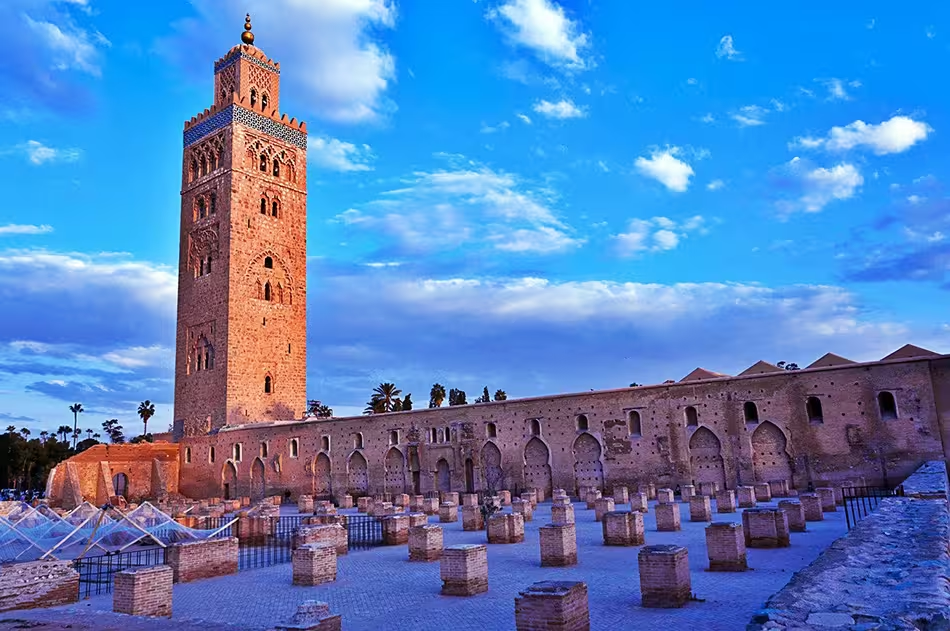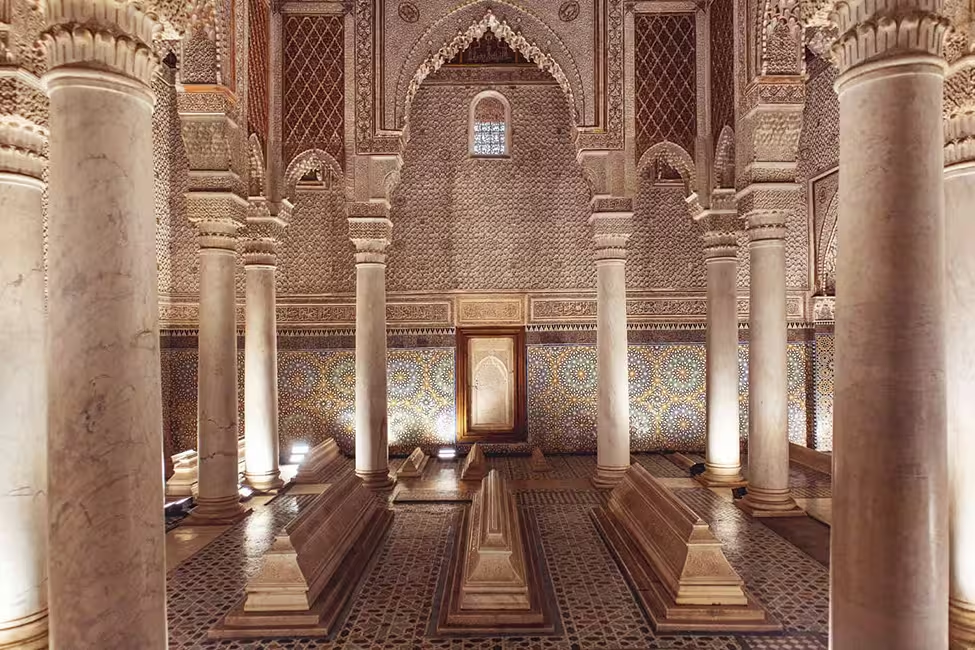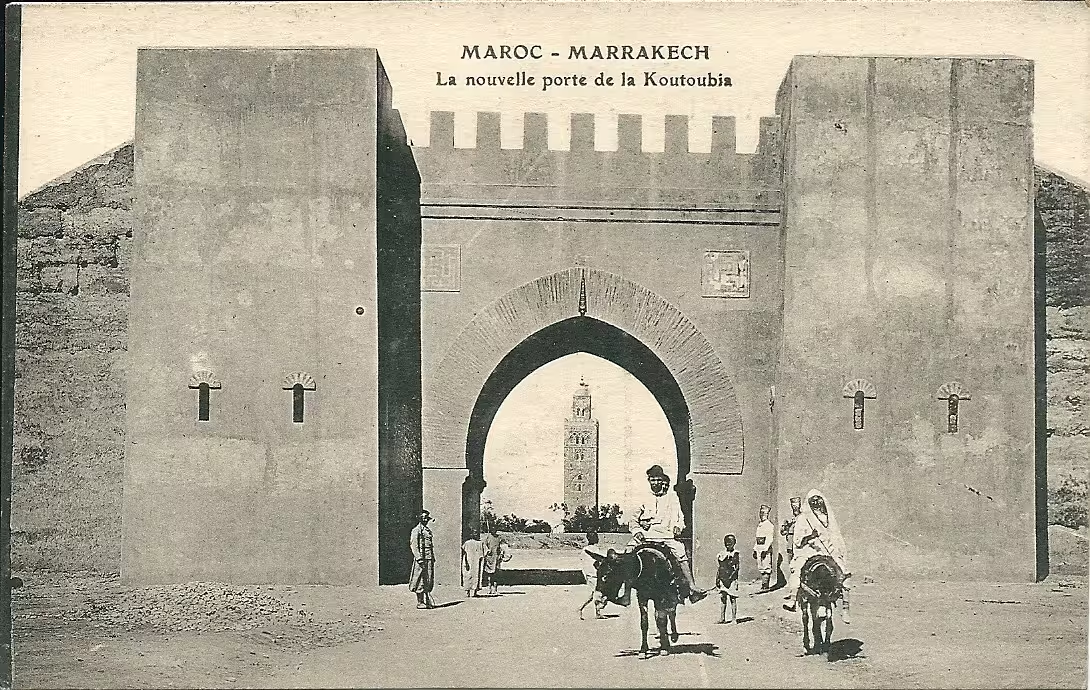
Marrakech's historical monuments
- History
- 2023-10-06

Marrakech is a city full of culture, history and beauty! There are many historic monuments you can explore to better understand Marrakech's past. From the imposing Kasbah to the iconic Koutoubia Mosque, we've rounded up some of Marrakech's most impressive historic monuments - so you can get an authentic look at this vibrant city.
Marrakech, also known as the Pearl of the South or the Red City, is a city in Morocco located at the foot of the Atlas Mountains. It is one of Morocco's four imperial cities and a major destination for tourists and business travellers. The city has a rich culture and history dating back hundreds of years, and is known for its vibrant nightlife, incredible markets and stunning architecture.
Marrakech's most iconic monument is the Koutoubia Mosque, located near the Djemaa El-Fna market. Built in 1150 AD, its 77-metre-high minaret can be seen from all over the city. The medina (old town) is surrounded by high walls stretching for almost 10 kilometres and is home to many traditional Moroccan houses as well as some of Marrakech's most important monuments, such as the El Badi Palace (1578) and the M'Nebhi Palace, which today houses the Marrakech Museum.
Marrakech offers a unique blend of traditional culture and modern facilities, making it one of Morocco's most popular destinations for both tourists and business travellers. With its bustling souks (markets), lively nightlife and stunning architecture, it's no wonder Marrakech remains one of Morocco's top attractions!
The Koutoubia Mosque
The Koutoubia Mosque is the largest mosque in Marrakech, Morocco, and one of the city's most emblematic monuments. Built in the 12th century by the Almohad dynasty, it stands 70 metres high and is an impressive sight to behold. The Koutoubia mosque boasts a 77-metre-high minaret that serves as the symbol of Marrakech and can be seen from almost every square in the city. This grand mosque was once one of the greatest places of worship for followers of Islam and remains a must-see for visitors exploring the medina of Marrakech. This magnificent structure is a reminder of Morocco's rich history and culture, making it a must-see attraction for anyone visiting this bustling city.
Bahia Palace
The Bahia Palace is a magnificent 19th-century palace in the city of Marrakech, Morocco. Built between 1866 and 1867 by Si Moussa, the grand vizier of the Alawite sultan, this sprawling complex covers more than two acres and comprises 150 rooms filled with superb stucco, paintings and mosaics.
Located along Bahia Bab street in the Mellah district of the medina, the palace is renowned for its intricate marquetry and plasterwork details and zouak (painted wood) motifs. It is also widely known for its peaceful gardens, which offer an oasis of peace in the hustle and bustle of Marrakech.
The Bahia Palace has been a major historical monument in Morocco since its construction. The site has been visited by many tourists over the years, who come to marvel at its beauty and discover a piece of Moroccan history. Although most of its rooms are now empty, visitors can still explore parts of the palace that have been preserved to this day.
This iconic palace is a testament to Marrakech's rich cultural heritage and serves as an important reminder of the country's past. Its unique architecture also provides a glimpse into Morocco's traditional arts and crafts.
The Saadian Tombs
The Saadian Tombs are a historic royal necropolis located in Marrakech, Morocco. This magnificent complex was built during the reign of Sultan Ahmad al-Mansur in the late 16th century and is now a UNESCO World Heritage Site. It consists of two magnificent mausoleums and is the only vestige of the Saadian dynasty, who were the founders of Marrakech. Inside these tombs, seven sultans and 62 family members are buried, with more than 100 others outside in the gardens.
Visitors to this site can marvel at its intricate details and complex designs. The walls are beautifully decorated with cedar wood panels, stucco mouldings and carved motifs painted in gold and silver. The ornate ceiling is made of cedar wood decorated with coloured glass stars.
The Saadian Tombs have been open to the public since 1917 and have become one of Marrakech's most popular tourist sites. Located just outside Marrakech city centre, visitors can easily access this site by strolling a short distance from the main square. This is an excellent opportunity for travellers to learn about Moroccan history and culture while admiring the beautiful architecture of these tombs.
Mais Et Said Museum
The But And Said Museum is an impressive museum located in the heart of Marrakech, Morocco. This 19th-century palace was created by Si Saïd Ben Moussa, who was a leader in the Moroccan government. The Dar Si Saïd museum is dedicated to showcasing the Moroccan crafts of weaving and carpets, as well as honouring traditional Moroccan art forms. Visitors to the museum can explore a wide range of artefacts, such as weapons, jewellery and pottery. There is also an interactive section that allows visitors to learn more about the history and culture of Morocco. In addition, visitors can admire superb paintings by Delacroix and enjoy breathtaking views from the terrace. The museum is open daily from 10am to 7pm and is a great place to explore the history of Morocco's rich culture.
Medersa Ben Youssef
The Ben Youssef madrasa is an Islamic college located in Marrakech, Morocco. Founded in 1364, the madrasa served as a temple of education for over 500 years under the Marinid dynasty. It is one of the oldest and most important Islamic schools in Morocco, housing over 900 students in more than 130 rooms. The building was renovated in 1999 and turned into a museum, becoming one of the most popular sites in Marrakech.
The Ben Youssef Medersa boasts striking architecture representative of the art of the Saadian period. With its intricate designs and sumptuous decorations, it is considered an architectural gem. Its exterior is decorated with zellige tiles, sculpted plaster and ornate stucco carvings, while its interior is made up of various classrooms and amphitheatres adorned with wooden carvings and beautiful mosaics.
The Ben Youssef Medersa was traditionally used to teach students the Koran and other aspects of Islamic law. Today, this ancient school has been adapted to offer educational opportunities to all, regardless of religious beliefs or background. The madrasa offers courses in Arabic language, literature, history and culture, as well as other subjects relating to Moroccan society, such as human rights, women's rights, ecology and sustainable development.
El Badi Palace
Palais El Badi est un palais emblématique situé à Marrakech, au Maroc. On pense qu'il a été construit à la fin des années 1570 sur les ordres du sultan Ahmed el Mansour de la dynastie Saadi. Le palais a été conçu comme un symbole de richesse et de pouvoir, mettant en valeur des matériaux exotiques importés du monde entier, comme l'Italie et le Mali. Bien qu'une grande partie du palais ait été détruite au fil du temps, il se dresse encore aujourd'hui comme un rappel de son ancienne gloire.
Le palais El Badi était à l'origine composé de 360 pièces réparties sur quatre cours entourées de hauts murs et de tours. À l'intérieur se trouvaient de belles mosaïques, des colonnes de marbre et des fontaines en or et en argent. Le palais contenait également une grande bibliothèque, qui abritait certains des manuscrits les plus importants écrits au cours de cette période.
Aujourd'hui, les visiteurs peuvent explorer ce qui reste du palais El Badi, qui comprend des parties des murs, des tours et des jardins d'origine. Il existe également plusieurs visites disponibles qui permettent aux visiteurs d'en apprendre davantage sur son histoire et de voir des vues incroyables depuis sa terrasse sur le toit. Pour ceux qui recherchent une expérience unique, il y a aussi des spectacles programmés tout au long de l'année qui dépeignent la musique et la danse marocaines traditionnelles devant ce décor spectaculaire.
Jemaa el Fnaa Square
Discover the sights and sounds of Jemaa el-Fnaa Square in Marrakech, Morocco. Located in the old town of Marrakech, this lively square is an essential part of the city's heritage and has been a UNESCO World Heritage Site since 1985. During the day, you'll find a wonderful mix of street artists, vendors and artisans selling their wares. But when night falls, Jemaa el-Fnaa really comes alive!
The iconic square is transformed into a magical experience with snake charmers, acrobatic performances, storytellers and much more. As well as the entertainment, there are delicious food stalls serving traditional Moroccan dishes such as tagine and couscous. The atmosphere is electric with vibrant music and lively conversation filling the air. It really is an unforgettable experience that you won't find anywhere else in Morocco!
So, if you're looking for an exciting night out while exploring Marrakech, make sure you spend some time in Jemaa el-Fnaa Square. With its unique atmosphere, it's no wonder it's one of Morocco's most popular attractions!
Tour du Jardin et du Pavillon
Visit the Ménara Marrakech gardens and pavilion to explore a centuries-old garden in the heart of the city. This 100-hectare garden is part of a UNESCO World Heritage Site and dates back to the Almohad dynasty. With a Hop On - Hop Off bus tour, visitors can explore the gardens from both a historical and cultural perspective. Take a stroll around the lake, admiring the 19th-century pavilion from several angles while admiring the view of the Atlas Mountains in the distance. In addition, visit the Majorelle Garden, the Bahia Palace, the Saadian Tombs and much more for an intimate insight into the culture and history of Marrakech. Throughout this day trip, admire breathtaking scenery while discovering local customs and architecture.
Majorelle Garden
The Majorelle Garden is a one-hectare botanical garden and artist's landscape garden located in Marrakech, Morocco. It was created in 1924 by the French painter Jacques Majorelle, who settled in Marrakech. Covering an area of 9,000 m², the Jardin Majorelle is a prime tourist destination and home to around 3,000 species of plant. It houses an art deco villa known as the Maison des Illustres and a museum dedicated to the work of Jacques Majorelle.
The garden was purchased by Yves Saint Laurent and Pierre Bergé in 1980, who were captivated by its beauty during their visit to Marrakech. Since then, the Majorelle Garden has become an exotic wonder, attracting visitors from all over the world with its vibrant colours and lush vegetation. What's more, it lies close to the emblematic Menara Garden, from where you can enjoy breathtaking views of the Atlas Mountains.
To visit this magical place, you need to buy tickets online at least 24 hours before your visit. As well as admiring the beauty of the Majorelle Garden, you can also enjoy exhibitions relating to the life and work of Yves Saint Laurent in his studio located within the garden.
Jardin Jardin Secret
The Secret Garden, located in the heart of Marrakech's medina, is a complex of palaces and gardens that dates back over four hundred years to the Saadian dynasty. It was rebuilt in the mid-nineteenth century and has been carefully restored in recent decades. Visitors to the secret garden can explore a wealth of historical information about the architecture, water and gardens of Marrakech.
The exotic garden is a fully reconstructed traditional Islamic garden with plaques providing information about each area. The Islamic garden has an irrigation system that is unique in Morocco and was only discovered when workmen began digging up the riad to restore it.
In recent years, Laurent and Pierre Bergé have opened the Secret Garden to the public for the first time in its history. Visitors can now explore this magnificent sanctuary and marvel at its history and beauty. Take a guided tour of this incredible garden to discover fascinating details about its construction, design and culture.
Tiskiwin House Museum
The Tiskiwin House Museum is a historic house in Marrakech, Morocco, which houses an impressive collection of Berber art and artefacts. It is one of the oldest museums in Marrakech and was once the home of Dutch anthropologist Bert Flint. The museum displays Moroccan art, artefacts and photographs of historic Marrakech, as well as decorative Saadian tombs.
The house has suffered considerable deterioration over time, but it remains an architectural gem. Mr Flint has lived in Morocco since the 1950s and his house is situated between the Bahia Palace and Dar Villa Dinari. It is close to many of Marrakech's fabulous sites but detached enough for tranquillity.
The museum features many large carved wooden doors throughout its exhibits, offering visitors a unique experience as they explore the different sections that represent a caravan stop along their journey to Timbuktu and back. Visitors can learn historical anecdotes from their guide while enjoying this unique experience. The exact address of the Tiskiwin House Museum is: Maison Tiskiwin, Riad Zitoun Jdid, Bab Doukkala, 40000 Marrakech, Morocco and it is open every day from 9am to 4pm.
Ben Youssef Cultural Centre
The Ben Youssef Cultural Centre is a renowned historical and cultural monument located in the heart of Marrakech, Morocco. Built in the 16th century by the Saadian dynasty, the centre served as an Islamic school and was one of the most important centres of learning in the whole of Morocco. The centre consists of a vast courtyard with a shallow pool in the middle, reflecting the beautifully crafted wood and marble sculptures that adorn the walls and ceilings. Today, visitors to the centre can explore its many rooms and courtyards, learn more about its history and discover the traditional Moroccan crafts on display. The Menara Gardens, Majorelle Gardens and other nearby attractions provide the perfect backdrop for exploring this unique cultural destination. Whether you want to learn more about Islamic culture or take in the sights, the Ben Youssef Cultural Centre is sure to provide an unforgettable experience.
Marrakech Museum
The Marrakech Museum is a magnificent 19th-century palace in the heart of Marrakech, Morocco. It houses a vast collection of art, weapons, pottery and other historical artefacts from Marrakech's past. The museum houses a number of galleries showcasing different periods of Moroccan history and art forms. These include the Aman museum, which exhibits traditional Moroccan art, and the Boucharouite museum, which displays contemporary pieces. The centrepiece of the museum is the large courtyard, where visitors can relax and enjoy the palace's beautiful architecture. In addition to its exhibition rooms, the museum also hosts educational events such as lecture series, workshops and films on Moroccan culture. Visitors to the Marrakech Museum can also buy souvenirs in their gift shop or explore their library for more information on Moroccan culture.

